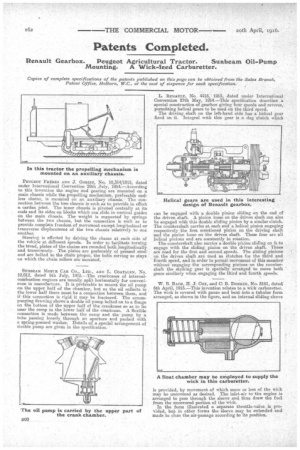Patents Completed.
Page 22

If you've noticed an error in this article please click here to report it so we can fix it.
Renault Gearbox. Peugeot Agricultural Tractor. Sunbeam Oil,-Pump Mounting. A Wick-feed Carburetter.
Copies of complete specifications of the patents published on this page can be obtained from the Sales Branch, Patent Office, Holborn, W.C., at the cost of sixpence for each specification.
PEUGEOT Frikas AND J. Gonna', No. 10,314/1915, dated under International Convention 29th July, 1914.—According to this invention the engine and gearing are mounted on a main chassis while the propelling mechanism, preferably endless chains, is mounted on an auxiliary chassis. The connection between the two chassis is such as to provide in effect a cardan joint. The inner chassis is pivoted centrally at its ends and its sides on blocks which can slide in vertical guides on the main chassis. The weight is supported by springs between the two chassis, but the connection is such as to provide complete freedom of movement except longitudinal or transverse displacement of the two chassis relatively to one another.
Steering is effected by driving the chains at each side of the vehicle at different speeds. In order to facilitate turning the tread, plates of the chains are rounded both longitudinally and transversely. The plates are preferably of pressed steel and are bolted to the chain proper, the bolts serving as stays on which the chain rollers are mounted.
SUNBEAM MOTCR CAR CO" LCD, AND L. COATALEN, NO. 10,012, dated 9th July, 1915.—The crankcases of internalcombustion engines are usually split horizontally for convenience in manufacture. It is preferable to mount the oil pump on the upper half of the chamber, but as the oil collects in the lower half there must he a connection between them, and if this connection is rigid it may be fractured. The accompanying drawing shows a double oil pump bolted on to a flange on the bottom of the upper half of the crankcase so as to ho near the sump in the lower half of the crankcase. A flexible connection is made between the sump and the pump by a tube passing loosely through an aperture and packed with a spring-pressed washer. Details of a special arrangement of double pump are given in the specification. • L. RTMAULT, No. 4416, 1915, dated under International Convention 27th May, 1914.—This specification describes a special construction of gearbox giving four speeds and reverse, permitting helical gears to be used on the third speed.
The driving shaft on the left-hand side has a helical gear fixed on it. Integral with this gear is a dog clutch which can be engaged with a double pinion sliding on the end of the driven shaft. A pinion loose on the driven shaft can also be engaged with this double sliding pinion by a. similar clutch. The countershaft carries at each end a helical pinion engaging respectively the first mentioned pinion on the driving shaft and the pinion loose on the driven shaft. These four are all helical pinions and are constantly in rotation. The countershaft also carries a double pinion sliding on it to engage with the sliding, pinion on the driven shaft. -These are used for the first and second speeds. The sliding pinions on the driven shaft are used as clutches for the third and fourth speed, and in order to permit movement of this member without engaging the corresponding pinions on the countershaft the striking gear is specially arranged to move both gears similarly when engaging the third and fourth speeds.
W. B. BACR, H. J. Cox, and a B. Doxerar, No. 5161, dated 6th April, 1915.—This invention relates to a wick carburetter. The wick is covered with gauze and bent into a tubular form arranged, as shown in the figure, and an internal sliding sleeve
is provided, by movement of which more or less of the wick may be uncovered as desired. The inlet-air to the engine is arranged to pass through the sleeve and thus draw the fuel from the uncovered portion of the wick. In the form illustrated a separate throttle-valve is provided, but in other forms the sleeve may be extended and made to close the air-passage according to its position.






















